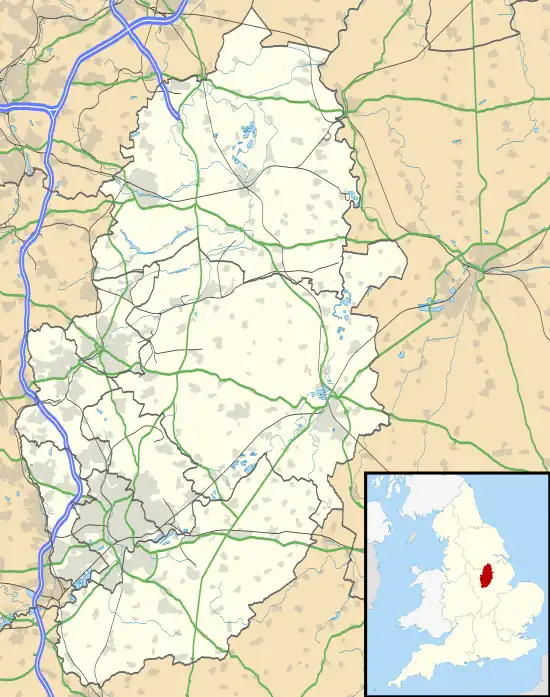Rampton, Nottinghamshire
Rampton is a village in the civil parish of Rampton and Woodbeck, about 6 miles (10 km) east of Retford in the Bassetlaw district, in the county of Nottinghamshire, England. The parish is long and thin, extending about 7 miles (11 km) east–west but only about 1 mile (1.6 km) north–south. Its eastern boundary is the River Trent, which here also forms the county boundary with Lincolnshire.
| Rampton | |
|---|---|
 All Saints' parish church | |
 Rampton Location within Nottinghamshire | |
| Population | 1,139 (2011 Census) |
| OS grid reference | SK798785 |
| Civil parish | |
| District | |
| Shire county | |
| Region | |
| Country | England |
| Sovereign state | United Kingdom |
| Post town | Retford |
| Postcode district | DN22 |
| Dialling code | 01777 |
| UK Parliament | |
The parish is best known for Rampton Secure Hospital, which is at the hamlet of Woodbeck about 1.5 miles (2.4 km) west of Rampton village. The parish was renamed from Rampton to Rampton and Woodbeck on the 1st of April 2018.[1]
The 2011 Census recorded the parish population as 1,139.[2][3]
History
The toponym "Rampton" is probably derived from Old English Ramm-tūn, meaning "farmstead where rams are kept".[4]
The village was an important manor from Norman times. The old manor house was pulled down around 1720, having been held by the Stanhope and Babington families. All that survives is the gateway, which includes the arms of Babington.
On the eastern boundary of All Saints' churchyard is a mid-16th-century Tudor gateway to Old Manor Farm. It is brick with terracotta panels and is a Grade I listed building.[5] It used to lead to the manor house, which was demolished about 1851.[6]
The area used to be served by Cottam railway station, just over 1 mile (1.6 km) northeast of Rampton village. The station opened in 1850 and closed in 1959.
Parish church
The oldest part of the Church of England parish church of All Saints is a 10th-century Anglo-Saxon column in its north arcade. Most of the building is Gothic or later, from the 13th to 17th centuries. The building was restored in 1894.[7]
The west tower is 13th-century and has a ring of six bells. George I Oldfield of Nottingham cast the third bell in 1622 and the fifth bell in 1635. Thomas Hilton of Wath-upon-Dearne cast the fourth bell in 1809. John Taylor & Co of Loughborough cast the treble, second and tenor bells in 1947.[8] The church is a Grade I listed building.[7]
All Saints' parish is part of the Benefice of Retford Area Team Ministry.[9]
References

- "Notice of change of name of Parish of Rampton" (PDF). Bassetlaw District Council. Retrieved 27 December 2018.
- "Area: Rampton (Parish): Key Figures for 2011 Census: Key Statistics". Neighbourhood Statistics. Office for National Statistics.
- "Area: Rampton CP (Parish): Parish Headcounts, 2001". Neighbourhood Statistics. Office for National Statistics.
- Mills 1991, "Rampton Notts.".
- Historic England. "Gateway from Manor Farm to churchyard and attached walls 7 metres west of Manor Farmhouse (Grade I) (1276407)". National Heritage List for England. Retrieved 1 December 2016.
- Pevsner & Williamson 1979, p. 292.
- Historic England. "Church of All Saints (Grade I) (1233879)". National Heritage List for England. Retrieved 1 December 2016.
- Dawson, George (1 January 2014). "Rampton All Saints". Dove's Guide for Church Bell Ringers. Central Council for Church Bell Ringers. Retrieved 1 December 2016.
- Archbishops' Council. "Benefice of Retford Area Team Ministry". A Church Near You. Church of England. Retrieved 1 December 2016.
- "the eyre arms at rampton village". www.eyrearmsrampton.com. Retrieved 18 May 2021.
- "Home | Rampton Primary School". www.ramptonprimary.co.uk. Retrieved 18 May 2021.
Sources and further reading
- Mills, AD (1991). A Dictionary of British Place-Names. Oxford: Oxford University Press. ISBN 0-19-869156-4.
- Pevsner, Nikolaus; Williamson, Elizabeth (revision) (1979) [1951]. Nottinghamshire. The Buildings of England (2nd ed.). Harmondsworth: Penguin Books. pp. 292–293. ISBN 0-14-071002-7.
- Thoroton, Robert; Throsby, John (1796). Thoroton's History of Nottinghamshire: Republished With Large Additions By John Throsby. Vol. 3. Nottingham. pp. 241–248.